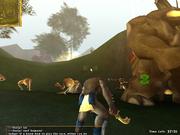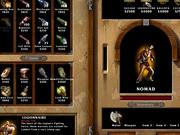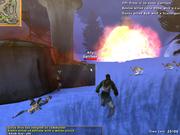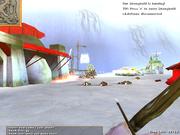For years now, shooters and real-time strategy games have been the staples of PC gaming. Savage: The Battle for Newerth combines conventional aspects from each of these genres to form an original whole. It's a multiplayer shooter with real-time strategy elements and, for good measure, a little role-playing-game-style leveling up. But rather than having broad appeal for fans of either of these types of games, Savage is only suitable for those who love both. A steep learning curve and the absence of either a tutorial or an offline mode means you'll be a liability to your teammates as you try to learn the ropes in Savage. Even after you get over the initial hurdles, you'll still find that the quality of the average match in Savage varies drastically--the odds of finding a game in which everyone understands his or her role are relatively slim. However, these uncommon matches can be worth the gamble, as the experience of playing a part in one of Savage's pitched, drawn-out battles can certainly be satisfying.

Savage takes place in a point in time far into the future, in the wake of humankind's having blasted itself back into the stone age. Humans have once again asserted themselves as rulers of the planet, but most of their technology is long forgotten, and instead, they live as hunters and gatherers. Their sworn enemies are the beasts, a faction of intelligent apelike creatures who've had it with the humans' oppressive ways and are seeking to overthrow them. The beasts' shamanistic magic is the perfect counterpart to the humans' primitive weaponry, so the humans and beasts remain locked in perpetual conflict for supremacy over what they call "Newerth," a lush and wild planet free from the civilizations that are spread across it today. This is an interesting premise manifested in a nicely done introductory cinematic and in the game's manual, but it has no real bearing on or during the game. There's no sense during the matches that you're playing in a far-flung future rather than on some random primitive planet covered in hills and rain forests. Perhaps a collapsed Statue of Liberty would have helped put the situation in better perspective? At any rate, the story isn't important--the important thing is that you're trying to destroy the enemy side's base.
Though you can play as either the humans or the beasts, the goal of any Savage match is always the same. Some matches can end quickly if one side or the other manages to coordinate a successful early-game rush, but generally, matches can take a half hour to an hour and may involve more than a dozen players on each side. Most of these players end up fighting against each other, scouting the territory, and assisting with the gathering of resources and the construction and repair of various buildings (like a Warcraft peon, you can just repeatedly whack at something to help build or repair it). Two players serve as the commanders of their respective sides. The difference between being a regular player and a commander is as drastic as the difference between playing a shooter and a real-time strategy game.
A good match of Savage should have approximately 20 players or more, but no matter how many players are involved in the proceedings, the commanders are always by far the most important. These players oversee the action from a bird's-eye view and have at their fingertips an interface that looks like it could have been lifted from any real-time strategy game released in the last few years. And, sure enough, commanders are charged with the sorts of tasks that real-time strategy fans are well accustomed to: gathering resources, building new structures, researching new weapons and abilities, setting up base defenses, expanding into new regions, and, ultimately, coordinating a crushing attack against the enemy. Of course, unlike in a typical real-time strategy game, a Savage commander does not have direct control of his units (except for worker units used for building and gathering resources). Nevertheless, the commander may select any player on his side, as though that player were a unit in a real-time strategy game, and order that unit to attack a certain target, proceed to a certain point, repair or build a certain structure, and so on. This player, meanwhile, receives verbal orders and a clear waypoint to follow and will hopefully be compelled to follow the commander's wishes.

The commander is capable of rewarding players for dutifully following orders by giving them gold, promoting them to officer status, or granting them various other benefits. The commander is also the only player capable of issuing build orders and of controlling worker units. Since the commander has exclusive control over which buildings (and therefore which weapon and unit upgrades) are available, the team's hope rests primarily on his or her shoulders. Indeed, it's a common sight in Savage for the commander of the losing side to be thoroughly berated by frustrated players, who, when killed, have up to 30 seconds before they respawn to type all kinds of very nasty messages. The Catch-22 is that there's absolutely no way to learn how to be an effective commander except by just diving right in. The best way to prepare for the responsibility would be by thoroughly reading the manual (which, unfortunately, isn't very informative), playing a whole bunch of matches as a regular player, and then attempting to play as commander on a server with nobody playing. This way, at least, you could get a sense of how sluggishly your worker units are to control, what the various buildings available to you actually do, and approximately how long it takes to gather up the resources to build them. It would have been very helpful if Savage featured a spectator mode from the commander's point of view, allowing aspiring commanders to witness a skilled commander's actions and learn a thing or two that way.
Savage does contain the standard elements found in real-time strategy games. Defensive towers can be built and upgraded. Various parallel research options are available. The humans' stronghold and the beasts' lair--the hearts of their respective operations--may be upgraded, unlocking more-powerful units for players to use. Yet, the real-time strategy portion of the game is about as cumbersome as it is intimidating. Would-be commanders may find that distinguishing between friendly and enemy units can be difficult at a glance, and overseeing their resource-gathering operations and their construction and research doesn't really leave much time for typing messages to teammates. A voice chat feature would have really helped, at least for the commander, though all players have access to some speech macros like "enemy sighted" and "return to base." At any rate, the commander certainly tends to keep busy during a Savage match. And, if not, players may vote to have the commander impeached--though, this process can be disruptive enough to give the opposing side a major advantage.
Most players during a Savage match experience a fairly conventional multiplayer shooter, at least from a gameplay standpoint. By default, you'll switch between a third-person and a first-person perspective depending on whether you're using melee or ranged weaponry, and you'll use these to try to take down as many enemy players as possible. Unlike in most shooters, melee weapons play an important role in Savage--they're very strong, while most ranged weapons aren't as powerful and provide you with little ammunition to spare. No matter how you do it, though, defeating enemies earns you gold and experience. Gaining experience levels grants slight improvements to your character for the duration of the match, while gold is used to buy better-than-default weapons or units, which make you a more-capable, longer-lasting killing machine. In a nod to Warcraft III, you can also seek and destroy computer-controlled critters to earn gold. These are completely stupid but they do hit hard, and they're the best means of earning a good amount of cash early on in a match.

The differences between the human and beast sides aren't staggering, but they're significant. Each side has a total of five units--three progressively stronger fighters and two siege units. The siege units at least look very different between the two sides; the humans have a ballista and a catapult, while the beast equivalents are a diminutive shaman who casts damaging long-ranged spells and a lumbering behemoth armed with a tree trunk. The standard human and beast units have one key difference: Humans can block with their melee weapons, deflecting frontal attacks, while the beasts have a short, quick pounce that can be used to gain ground on an enemy or avoid getting hit. The selection of weapons is also different between the two sides. Humans have access to ranged weapons earlier, while the beasts can gain upgraded melee attacks. Different items are available to each faction, as well. The beasts can camouflage themselves, becoming practically invisible. The humans can carry health and ammo packs, as well as explosive bombs for taking out beast buildings. Either side has some interesting options and is fully capable of defeating the other. The beasts, being more mobile and stronger toe-to-toe, are probably a bit more fun to play. But the humans' blocking ability isn't to be underestimated, and a skilled human player may use it to counter an overzealous beast player.
However, typically, the action just doesn't feel very satisfying, which is one of the game's more serious shortcomings. Players move about the battlefield in a jerky fashion, regardless of the quality and speed of your Internet connection, and most of the game's ranged weapons feel flimsy and underpowered. They're like pea shooters, spitting out little colored projectiles straight forward, in a slight spread, or in a downward trajectory. Learning to aim these won't come quickly, though to be fair, mastering some of the long-ranged, deadlier weapons such as the humans' marksman bow can lead to some satisfying kills. Melee combat fares slightly better, since melee attacks look (and usually are) comparatively much more powerful, and the third-person perspective actually affords you with more visibility than the first-person ranged-weapon view. But, even so, close combat in Savage often boils down to pressing the left mouse button as quickly as possible while trying to keep the opponent in sight. There's some skill and timing involved, but plenty of blind luck as well.
Nevertheless, under good guidance from a competent commander, Savage can become quite interesting in the late game. When many weapons, items, and units are available to both factions, the gameplay becomes much more diverse, and the real-time strategy elements can start to shine. Players who take control over siege weapons must be escorted into battle, as these are too slow to defend themselves. Most of these siege weapons have tremendous range, making them essential for taking out enemy defensive turrets (they're plenty powerful against buildings, in general), which paves the way for standard units to rush in and start killing off workers or hitting other targets of opportunity. Coordination and teamwork just seem to come more naturally as a fight wears on, as more units and weapons are available, and as the enemy base comes into reach. Though the action isn't always great, and organized teamwork is hardly par for the course, Savage definitely has its moments.
Like most aspects of Savage, the game's visuals unfortunately aren't consistent, but they have flashes of inspiration and are mostly good. The proprietary engine developed for the game looks much better from a standard player's view than from the commander's. It does a respectable job of rendering rolling hills and various weather effects, which collectively make for some convincing-looking environments. Furthermore, many of the character models look good and animate well, particularly the higher-tier human units: the savage, a tough-looking bare-chested barbarian, and the legionnaire, an enormous pro-wrestler-looking character armed with a massive ax. The beasts' behemoth is impressive looking, too. However, the weapon models seen from the first-person view are universally weak, and worker units and the computer-controlled critters strewn about each map tend to look pretty bad, too. Even so, Savage is in no way an eyesore, and it does a particularly good job of making the stronger units look appropriately powerful.

Savage sounds better than it looks. It features an excellent, dramatic musical score that lends some cinematic flair to the action. If there's a downside to the music, it's that there isn't enough of it. Ranged weapon effects are pretty good, such as the sound of the humans drawing their bowstrings, but melee weapons again are better. Different voice-over is used for the humans and beasts, and typical spoken orders like "move here" or "attack this unit" are recorded in a few different inflections, which is quite a nice touch.
Many other aspects of Savage were thoughtfully designed, though the game is still inherently limited and thus inherently flawed. In a controlled setting--in matches consisting only of experienced and dedicated or at least open-minded players--the game is at its best, and everything comes together. But, fundamentally, the game assumes too much inherent understanding and tolerance from beginning players, many of whom, in reality, are not going to like suffering the wrath of their unforgiving teammates and will find themselves wishing they could practice with and against computer-controlled bots. Like other complex multiplayer shooters, this is a game that rewards hardcore dedication and that will be more entertaining if you can make a group commitment with other players willing to play on the same servers at the same times and using coordinated strategies. Unfortunately, the game includes no mechanisms to facilitate these types of arrangements, so most Savage players will find that their mileage will vary drastically from one match to the next. If you're undaunted by the game's singular insistence on coordinated teamwork, and intrigued by its combination of shooter and real-time strategy elements, then Savage is worth checking out.